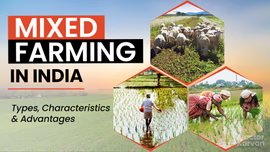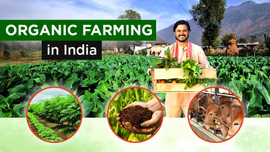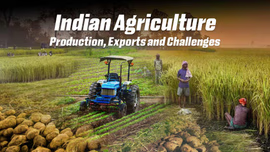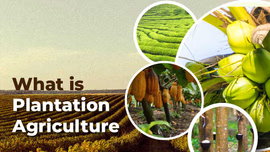Cinnamon Cultivation in India: Best Farming Practices

Cinnamon is one of the oldest and most renowned spices in the world. It has deep roots in India's agricultural and cultural history. Sri Lanka has historically dominated global Cinnamon production. However, in recent years, cultivation in India has steadily expanded in response to rising domestic and international demand. In this article, we will explore Cinnamon cultivation in India within the broader context of spice farming, from different varieties grown, the current export & import scenario, to best farming practices.
Keep reading to learn more.
Table of Contents
- History of Cinnamon Cultivation in India
- Different Varieties of Cinnamon Grown
- Step-by-Step Process for Cinnamon Farming
History of Cinnamon Cultivation in India
Cinnamon, also known as Dalchini (Cinnamomum zeylanicum), belongs to the Lauraceae family. It is one of the world's oldest known spices, with records dating back to 2000 BC when Egyptians used it for sacred ceremonies. True cinnamon, also known as Ceylon cinnamon, was first found in Sri Lanka. It was later introduced to Indian cultivators through trade and colonial efforts. Indian Ayurvedic texts from thousands of years ago also mention cinnamon and related cinnamomum species, which were used for various medicinal purposes. Today, Cinnamon cultivation in India is concentrated in the states of Kerala, Karnataka, and Tamil Nadu.
Different Varieties of Cinnamon Grown
Here are some of the different varieties of Cinnamon grown in India.
|
Variety |
Botanical Name (Type) |
Key Features |
Region(s) where grown in India |
|
Ceylon Cinnamon |
Cinnamomum Verum |
Delicate, sweet flavor; thinner, softer bark. Considered high quality. |
Kerala, Tamil Nadu. |
|
Cassia Cinnamon |
Cinnamomum Cassia |
Stronger, spicier flavor; harder, thicker bar. |
Grown in parts of Northern India. |
|
Malabar Cinnamon |
Cinnamomum Citridorum. |
Coarser, but mild aroma. May have citrusy notes. |
Wester ghats, coastal regions (Malabar coast), Kerala. |
|
Cultivar “Navashree” |
Selected variety of Cinnamomum Verum. |
High yield; good bark recovery; High bark oil. |
Suitable in various Cinnamon growing regions. |
Step-by-Step Process for Cinnamon Farming
Soil & Climate
Cinnamomum is adaptable to a wide range of soils and climatic conditions. It requires a warm and humid climate, with well-distributed annual rainfall of around 2000 – 2500 mm, and an average temperature of 27°C. It grows best at low altitudes and is usually grown without shade. Well-drained, fine, sandy, and lateritic gravelly soils is highly recommended for optimum plant growth. The quality of the 'bark' is affected by the soil and other ecological factors. Therefore, cultivation in waterlogged, marshy conditions should be avoided as it can result in bitter yield or root rot. Cinnamon is also considered susceptible to soil salinity.
Land Preparation & Planting
Before planting, ensure that the area for cinnamon cultivation is cleared. Start land preparation by digging pits of 50 X 50 X 50, at a 3 X 3 mm spacing and fill them with compost and top soil. Planting needs to be done between the months of June-July, during the onset of monsoon season for irrigation purposes. In each pit, 5 seedlings should be planted. Partial shade in the initial years is advantageous for healthy and rapid growth of plants.
Manuring & Fertilization
Weeding needs to be carried out twice annually: once during June–July and again in October–November. Soil around the plants should be loosened through digging between August and September. In the first year after planting, each seedling should receive a fertilizer dose of 20 grams of nitrogen (N), 18 grams of phosphorus (P₂O₅), and 25 grams of potassium (K₂O). As the plants mature, the fertilizer dosage is to be increased gradually, reaching up to 200 grams of nitrogen, 18 grams of phosphorus, and 200 grams of potassium for plants that are ten years old or older. The fertilisers are applied in two doses during the first week of September and March. Mulching with green leaves (25 kg) during summer and application of FYM (25 kg) during May-June is also recommended.
Irrigation
For watering the cinnamon tree, the soil should be lightly soaked. Do not water again until the top 2 inches of soil is dry. Depending on light conditions, location, and foliage, watering may be required weekly or daily.
Plant Protection
Cinnamon farming faces the threat of a variety of pests and diseases. However, effective plant protection using a combination of chemical and integrated management approaches assures a healthy, high-yielding plant. We've prepared a list of the most common diseases and pests in Cinnamon farming, as well as control measures.
Pests of Cinnamon and Their Management
The most commonly found pests that can damage budding Cinnamon plants are the caterpillars of the cinnamon butterfly, which are destructive to new flushes, and shot-hole borers, which damage the stem and bark. Leaf miners, gall and leaf mites, leaf webbers and arboreal ants also cause occasional damage.
Psyllid bugs: It feeds on leaves. Spray 05 % endosulphan or 0.05 % quinolphos for prevention.
Stem Borer: It feeds on the bark of the tree and can be controlled by spraying Lindane powder.
Leaf Miner and Tussock Caterpillar: It can be controlled by spraying 05 % quinolphos.
Diseases of Cinnamon and their Management
Stripe canker: Damages the trunks and branches of young trees. Symptoms being vertical strips of dead bark, particularly near ground level.
Pink disease: It causes pink encrustations on the stem with death of small shoots.
Stem rot: It is a fungus disease causing flaking-and rotting. It can be controlled by spraying 1 % Bordeaux mixture.
Harvesting & Post-Harvesting
Harvesting of cinnamon in India typically begins three to four years after planting, once the stems reach an ideal size and bark develops its characteristic brown colour and aroma. Farmers commonly harvest cinnamon twice a year, after the rainy season, since humidity makes peeling the bark easier. Cinnamon plants are coppiced, meaning the main stem is cut 12 cm close to the ground. Stems that are about 1.0 - 1.25 meters long and finger thick are selected for bark extraction. Special knives are used to scrape off the outer bark. Afterwards, the inner bark is peeled off in thin strips, which naturally curl into quills.
The inner bark is then dried in the sun for several days. This is done to reduce the moisture content and retain essential oil and aroma. Some of the bark may be grounded into powder or used for oil-extraction.
Cinnamon Cultivation in India – Conclusion
India's cinnamon industry is growing steadily as a result of the increasing demand for this popular spice in both domestic and global market. A sizable portion of India's cinnamon production comes from southern states - Kerala and Karnataka mainly because of the conducive weather conditions. Due to the rising demand for high quality, organic spices, cinnamon cultivation is becoming a promising venture for both small and large farmers.
You can read more blogs on our website on best cultivation practices of other spices such as - Turmeric cultivation or Cardamom cultivation.
Frequently Asked Questions On Cinnamon Cultivation in India: Best Farming Practices
1. How long do cinnamon trees take to grow?
Cinnamon trees in India typically take 3 to 4 years to grow to their first harvestable stage after planting.
2. What is the cultivation season of cinnamon?
The main cultivation season for cinnamon is usually during the onset of the monsoon, with planting done between the months of June and July.
3. How do you cultivate cinnamon?
Cinnamon cultivation requires well-drained, fine sandy, and lateritic gravelly soil, with an annual rainfall of 2000-2500 mm. Prepare the land by digging pits of size 50 X 50 X 50 with 3 X 3 mm spacing and, in each pit, plant five seedlings.
4. Does cinnamon regrow after harvesting?
Yes, Cinnamon trees can regrow after harvest. During the harvesting process, only the outer bark and inner bark layers are removed. However, the tree remains evergreen and can sprout new shoots.
5. What is the best fertilizer for cinnamon?
Cinnamon requires a fertilizer dose of 20 grams of nitrogen (N), 18 grams of phosphorus (P₂O₅), and 25 grams of potassium (K₂O) during seedling stage. This fertilizer dosage should be increased gradually as the plants mature.


Related Blogs












